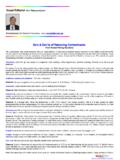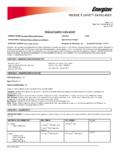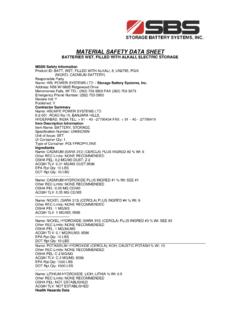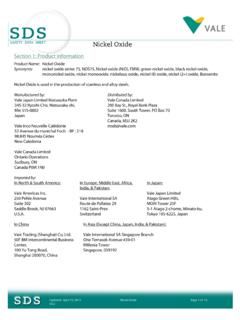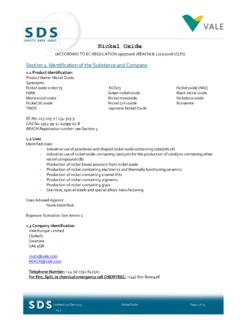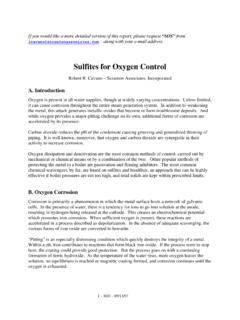Transcription of SORBITOL - fao.org
1 SORBITOL Prepared at the 46th JECFA (1996), published in FNP 52 Add 4 (1996) superseding specifications prepared at the 33rd JECFA (1988), published in FNP 38 (1988). Metals and arsenic specifications revised at the 57th JECFA (2001). An ADI Not specified' was established at the 26th JECFA (1982). SYNONYMS D-Glucitol, D- SORBITOL , sorbit, sorbol, INS No. 420(i) DEFINITION Chemical names D- SORBITOL number 50-70-4 Chemical formula C6H14O6 Structural formula Formula weight Assay Not less than of C6H14O6 of total glycitols and not less than of D- SORBITOL on the anhydrous basis. The term glycitols refers to compounds with the structural formula CH2OH-(CHOH)n-CH2OH, where n is an integer less than or equal to 4. DESCRIPTION White hygroscopic powder, crystalline powder, flakes or granules FUNCTIONAL USES Sweetener, humectant, sequestrant, texturizer, stabilizer, bulking agent CHARACTERISTICS IDENTIFICATION Solubility (Vol.)
2 4) Very soluble in water, slightly soluble in ethanol Melting range (Vol. 4) 88 - 102o Thin layer chromatography (Vol. 4) Passes test Proceed as directed under Thin Layer Chromatography of Polyols Use the following: Standard solution: Dissolve 50 mg of reference standard SORBITOL (available from US Pharmacopeial Convention, Inc. 12601 Twinbrook Parkway, Rockville, MD 20852, USA) in 20 ml water Test solution: Dissolve 50 mg of the sample in 20 ml of water PURITY Water (Vol. 4) Not more than 1% (Karl Fischer Method) Sulfated ash (Vol. 4) Not more than Test 2 g of sample (Method I) Chlorides (Vol. 4) Not more than 50 mg/kg Test 10 g of sample by the Limit Test using ml of hydrochloric acid in the control Sulfates (Vol. 4) Not more than 100 mg/kg Test 10 g of sample by the Limit Test using ml of sulfuric acid in the control Nickel (Vol.
3 4) Not more than 2 mg/kg Proceed as directed under Nickel in Polyols Reducing sugars Not more than Proceed as directed under Reducing Substances (as Glucose), Method II. The weight of cuprous oxide shall not exceed 50 mg Total sugars Not more than 1% (as glucose) Weigh g of the sample into a 250 ml flask fitted with a ground glass joint, add 40 ml of hydrochloric acid, attach a reflux condenser, and reflux for 4 h. Transfer the solution to a 400 ml beaker, rinsing the flask with about 10 ml of water, neutralize with 6N sodium hydroxide and proceed as directed under Reducing Substances(as Glucose) Method II. The weight of the cuprous oxide shall not exceed 50 mg. Lead (Vol. 4) Not more than 1 mg/kg Determine using an atomic absorption technique appropriate to the specified level. The selection of sample size and method of sample preparation may be based on the principles of the method described in Volume 4, Instrumental Methods.
4 METHOD OF ASSAY Determine the polyol content of the sample using liquid chromatography (see Volume 4). Apparatus Liquid chromatograph (HPLC) Detection: differential refractometer maintained at constant temperature Integrator recorder Column: AMINEX HPX 87 C (or equivalent resin in calcium form), length 30 cm, internal diameter 9 mm Eluent: double distilled degassed water (filtered through Millipore membrane filter m) Chromatographic conditions Column temperature: 85 Eluent flow rate: ml/min Standard preparation Dissolve an accurately weighed quantity of SORBITOL in water to obtain a solution having known concentration of about mg of SORBITOL per ml. Sample preparation Transfer about 1 g of the sample accurately weighed to a 50 ml volumetric flask, dilute with water to volume and mix. Procedure Separately inject equal volumes (about 20 l) of the sample preparation and the standard preparation into the chromatograph.
5 Record the chromatograms and measure the responses of each peak. Calculate separately the quantities, in mg, of SORBITOL and other glycitols in the portion of sample taken by the following formula: 50 x C x SURR in which C is the concentration, in mg per ml, of SORBITOL in the standard preparation; RU is the peak response of the sample preparation and RS is the peak response of the standard preparation.










